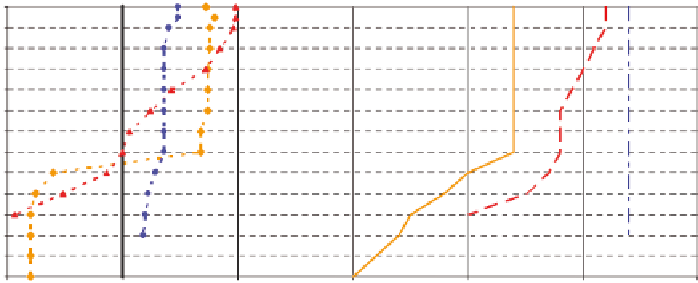Environmental Engineering Reference
In-Depth Information
0
1
2
3
4
5
6
7
8
9
10
11
12
13
0
5
10 15
DO mg L
-1
; Te mperature (°C)
20
25
30
1991 DO
1991 Te mp.
2006 DO
2006 Te mp.
2009 DO
2009 Te mp.
WQS
FIGURE 14.5
Oxygen and temperature proiles for Clinton Lake, Kansas, in comparison to the state's water
quality standard. (WQS; From KDHE, Water Quality Standards White Paper, Allowances for low dissolved
oxygen levels for aquatic life use, Kansas Department of Health and Environment, Bureau of Water, 2011.)
Lake, illustrated in Figure 14.5. Clinton Lake periodically stratiies and, during periods of stratiica-
tion, oxygen concentrations decline. Thus, during periods of stratiication, the state standards are
violated. Among the options considered by Kansas (KDHE 2011) for potential exceptions to the
state's rule is to “explicitly state allowances for dissolved oxygen lower than 5 mg L
−1
when caused
by documented natural conditions,” or to “explicitly exclude applying dissolved oxygen criteria to
the lowest portions of a lake (i.e., the hypolimnion).”
A
number of other states (e.g., Maryland, MDE 2004; Minnesota, MPCA 2003) do not currently
address the effects of stratiication on DO concentrations in their water quality regulations. For
Louisiana, the state standard is “for a diversiied population of fresh warm-water biota including sport
ish, the DO concentration (Section 1113 Title 33, Part IX, Subpart 1 May 2007) shall be at or above
5 mg L
−1
.” As illustrated in Figure 14.6 for an oxbow lake in Louisiana, this poses a similar problem
to that of Kansas, since the criteria are not met in the typically seasonally anoxic hypolimnion.
Some states address the issue by specifying a particular depth at which the criteria are applied. For
example, Mississippi (MDEQ 2007) standards for DO are daily average concentrations of not less
than 5.0 mg L
−1
with an instantaneous minimum of not less than 4.0 mg L
−1
, and for waters that are
thermally stratiied, based on samples that are at mid-depth of the epilimnion if the epilimnion depth
is 10 ft. or less, or 5 ft. from the water surface if the epilimnion depth is greater than 10 ft.
14.4.2 o
xyGen
S
aturatIon
As discussed in Section 14.1.4, one source of oxygen is the atmosphere, which is approximately 21%
oxygen (Table 14.1). Saturation concentrations vary as a function of temperature, salinity, and pres-
sure. The impact of temperature may be estimated from (APHA 1995)
5
7
1 575701 10
.
×
6 642308 10
.
×
ln (,)
oT
0
=−
139 34411
.
+
−
s
2
T
T
a
a
10
11
124
.
3800 10
×
8 621949 10
.
×
+
−
(14.7)
3
4
T
T
a
a










Search WWH ::

Custom Search